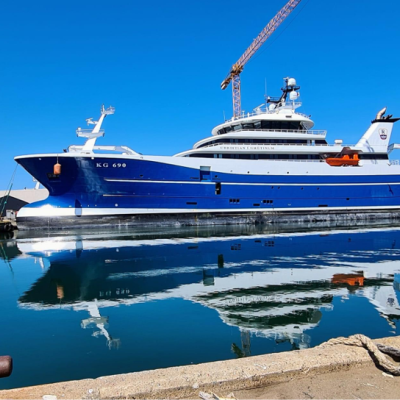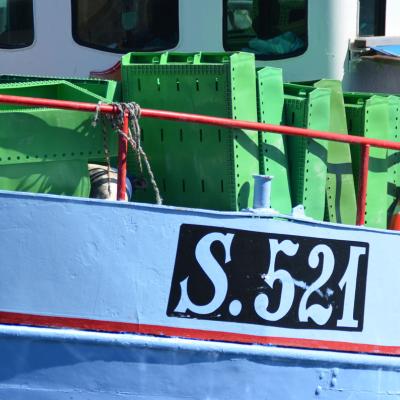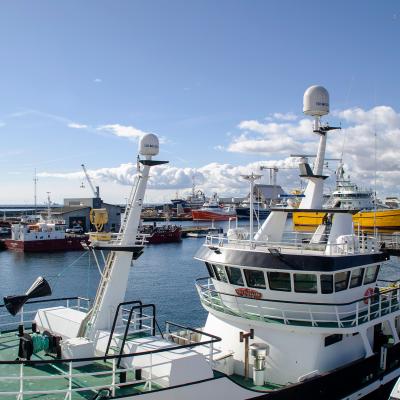Overview on the activity
The feasibility study at the Port of Skagen aims to assess the potential for integrating biofuels, such as Gas to Liquid (GTL) or biodiesel, into the port's operations based on locally available resources. The study will evaluate the technical and economic viability of using these alternative fuels, with a specific focus on meeting the fuel needs of the fishing fleet that operates at the port. It will also determine the necessary infrastructure for storing and distributing biofuels, and identify any legislative, logistical, or technical challenges that must be addressed for successful implementation.
This initiative aligns with the broader objectives of the REDII Ports project, which aims to enhance the capacity of ports in the North Sea Region to become hubs for renewable energy production and alternative fuel adoption. By promoting the use of biodiesel and other biofuels, the Port of Skagen will contribute to reducing the carbon footprint of maritime operations, in accordance with the EU's Renewable Energy Directive (RED II).
The feasibility study is part of a larger effort to introduce biofuels to the Port of Skagen's extensive fishing fleet, which consists of four main components:
- Waste Stream Evaluation:
- Map and evaluate local organic waste streams that could serve as raw materials for biofuel production.
- Feasibility Study:
- Conduct a detailed study of the technological, economic, and legislative barriers to the introduction of biofuel production and/or storage.
- Partnership Development:
- Foster partnerships with regional stakeholders to ensure sustainable practices and integration of biofuels.
- Implementation Strategy:
- Develop a comprehensive strategy to promote active participation from the local community and ensure long-term success.
Structure of the feasibility study:
This feasibility study explores the integration of biofuels, such as biodiesel and GTL diesel, into the operations of the Port of Skagen. It aims to assess the market demand, economic viability, and environmental benefits of adopting these alternative fuels for the local fishing fleet. The study also evaluates the necessary infrastructure adaptations and logistics planning required for a smooth transition. Key risks and mitigation strategies will be identified to ensure a sustainable supply chain. This comprehensive analysis supports the port's goal of reducing its carbon footprint while contributing to the broader REDII Ports initiative.
The feasibility study at the Port of Skagen will assess the potential for integrating biofuels (biodiesel and GTL diesel) into port operations. It includes:
Fuel Production & Supply:
- Local Resource Feasibility: Assess local biofuel feedstock availability and potential for sourcing GTL diesel from biogas, focusing on scalability for port needs.
- National Grid Integration: Evaluate the feasibility of integrating GTL diesel supply with the national gas grid.
Infrastructure Evaluation:
- Port Infrastructure Review: Inspect current fuel systems to identify necessary upgrades for biofuels and GTL diesel.
- Infrastructure Adaptation Plan: Provide recommendations for updating storage and fuel delivery systems.
Logistics Analysis:
- Fuel Logistics Planning: Develop a plan for efficient fuel purchasing, storage, and distribution during the transition.
- Logistical Solutions Proposal: Propose innovative ways to streamline the supply chain and reduce costs.
For more details, please contact:
Framework and first results
1.Waste Research:
In our feasibility study, we carried out a thorough analysis of waste data collected from the municipalities of Frederikshavn and Hjørring, placing a specific emphasis on organic waste sources.
Throughout this detailed investigation, we encountered numerous data discrepancies that amounted to up to 30% variation and out of the 30% only around 6% was unusable, these discrepancies is on numbers of registrations and not on weight of waste. These inconsistencies primarily stemmed from the mismatch of activity codes and used waste fraction codes which are, EAKCodes (URLCodes), WasteCodes, WasteActivity, RecoveryCodes and DisposalCodes, which were not suitably aligned. These errors are caused by waste collectors or waste receivers that don’t have sufficient experience in handling waste data and because the receivers of waste data haven’t had sufficient time to correct the misreported data.
To address these challenges, we conducted a critical assessment of these anomalies. Our method involved closely analyzing expected waste data patterns and cross-referencing our findings with similar datasets from other studies. This rigorous approach has not only enhanced the reliability of our data but also solidified the foundation of our study's recommendations, if other Ports have to analyze waste data from their regions they must take into account that discrepancies must be addressed. We identified several potential biofuel sources including agricultural waste, food waste (including UCO) and smaller quantities of other organic materials.
The conversion ratio of gas to liquid fuel ranges from 0.6 liters per cubic meter to 0.75 liters per cubic meter of gas, depending on the quality and composition of the source gas when using Fischer-Tropsch synthesis.
From our analyses, we concluded that local waste resources could potentially produce approximately 587,062 to 733,827 liters of GTL (gas-to-liquid) from upgraded biogas derived from regional waste streams. The possible GTL production from each fraction is, 158.522-198.153 liters from garden park litter, 297.088-371.360 liters from food waste, 128.709-160.886 liters from other organic waste and 2.741-3.427 liters from mixed sewage sludge.
However, this production capacity is significantly lower than the 200,000 cubic meters (200 million liters) of fuel currently utilized annually at the Port of Skagen. We know that there are agricultural fractions in Frederikshavn and Hjørring that are not included in the national waste register, due to classification under by products, which are accepted in REDII Directive, controlled by another department in the Ministry of Environment, that will increase the possible GTL production, despite this it still won’t be enough to meet the demand only using local waste, but these data are not available to us since they are not reported to a database like waste.
Additionally, our study explores the feasibility of incorporating non-organic waste into our biofuel production processes. Recognized under the REDII directive for their lower greenhouse gas (GHG) reduction values, materials like high-density polyethylene (HDPE) and old used tires, which are unsuitable for reuse, are considered.
HDPE, known for its durability and uniform properties, alongside these tires, offers a homogeneous feedstock that is ideal for pyrolysis process. Integrating these materials not only enhances the efficiency of the pyrolysis process but also optimizes the production capabilities of alternative fuel than can be used in current diesel engines. This strategic inclusion aims to improve overall output and contribute to the sustainability of the biofuel and other fuel production initiative.
Through these findings and explorations, our feasibility study aims to provide a blueprint for enhancing biofuel and other fuel production at the Port of Skagen. By addressing the challenges and opportunities within the current waste management and recycling frameworks, we hope to pave the way for more sustainable and efficient energy solutions.
Economy
Economy on possible fuel production converting Biogas to GTL will be conducted in the second half of the study due to lack of data to compare to other methods of producing GTL from biomass that doesn’t getting used in Biogas Plants, we find it better to have all data and calculations in line before publishing something that can give an overview with discrepancies.
2. Infrastructure Evaluation:
In alignment with our strategic objectives to integrate biofuel production from the national gas grid, our comprehensive assessment spans both infrastructural and regulatory landscapes.
We are dedicated to identifying key compatibility issues that could arise between the existing grid infrastructure and new biofuel production facilities. This involves an evaluation of pipeline capacities, connection points, and necessary upgrades to accommodate the transportation and storage of GTL diesel. Our goal is to establish a foundation for a seamless and efficient integration process that not only ensures a consistent supply of GTL diesel but also supports the broader transition towards sustainable fuel sources.
Current logistical challenges highlight that the distances of existing GTL plants are too vast to feasibly connect with the European Union's infrastructure without significant strategic planning and investment. This necessitates considering the further development of the interconnected network within the EU, potentially spurred by the establishment of regional GTL plants that are connected to the natural gas grid in EU.
Presently, operational GTL plants include:
- Royal Dutch Shell’s facility in Bintulu, Malaysia, which processes natural gas into diesel. Additionally, Shell operates the Pearl GTL plant in Qatar, recognized as the world's largest GTL facility.
- Sasol, which manages the Oryx GTL facility in Ras Laffan Industrial City, Qatar, and in partnership with Uzbekneftegaz and Petronas, is developing the Uzbekistan GTL plant.
- Chevron Corporation, in collaboration with the Nigerian National Petroleum Corporation, is initiating operations at the Escravos GTL in Nigeria, leveraging Sasol's advanced technologies.
- PetroSA, South Africa's national oil company, oversees a GTL plant in Mossel Bay with a daily capacity of 22,000 barrels, also utilizing Sasol's technology.
Given the critical need to adapt our GTL production strategies, especially considering the connectivity at Skagen Port or other similar ports, a shift towards smaller-scale, localized production units may provide a more viable solution to begin with. A combination of different kinds of fuels will be more likely than all shall have same the same solution, some ships can sail on one type of fuel others on other types of fuel but all of the types of fuel must be able to run on diesel engines like they do now.
Testing and Strategic Reevaluation:
Implementing this approach requires rigorous testing and detailed analysis. We are encouraged by preliminary results indicating that foundational work in this area is progressing, showing promise for future scalability. Furthermore, we anticipate the introduction of new types of biofuels into the market, such as pyrolysis oil derived from organic waste feedstocks or upgraded CNSL oil that are currently being developed and tested, which could diversify the biofuel mix and enhance sustainability profiles.
Our research shows that the existing biogas resources within the national gas grid are sufficient to meet the production needs for Skagen Port’s fishing fleet. Specifically, biogas facilities could potentially produce from 434 to 542 million liters of GTL annually from a total input of 723 million cubic meters of biogas. This volume significantly exceeds the port's current requirements, but it is likely that others will join to bid on the quantities available if successful projects pave the way.
Considering the conversion efficiency, the standard ratio of 0.6 liters of GTL per cubic meter of gas—based on variable natural gas quality—could be optimized to 0.75 liters per cubic meter, given the higher purity of biogas in the grid. This adjustment taking into account can highlight the need for projects or Plants being developed in larger scale earlier than the goal of being 100% CO2 neutral in 2050.
Future Considerations and Sustainability Goals:
Consuming nearly half of Denmark’s biogas output for GTL production underscores the need for a balanced approach to national energy policies. To expand GTL production sustainably, Denmark/EU must address several critical factors:
- Increasing Biogas Production: Scaling up biogas production capabilities is essential to meet rising energy demands without compromising environmental goals.
- Legislative Adjustments: Revising current laws to accommodate new types of biogas plants will be crucial, as will the acceptance of a broader range of waste fractions as sustainable inputs.
- Waste Management Strategies: Base on technology and research adjusting the ratios of agricultural to industrial waste used in biogas plants will help optimize the efficiency and sustainability of biofuel production.
In summary, our strategic reevaluation aims to not only enhance GTL production capabilities but also to align them closely with Denmark’s ambitions to become self-sufficient regarding gas in the natural gas grid in energy supply while advancing environmental sustainability.




